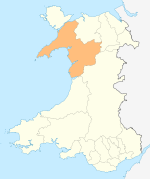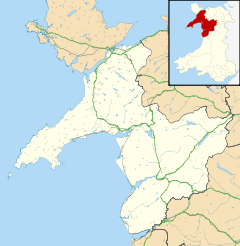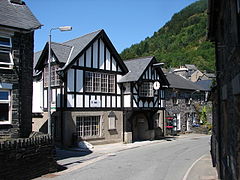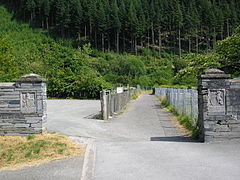- Corris
-
Coordinates: 52°39′13″N 3°50′31″W / 52.6536°N 3.8419°W
Corris
 Corris shown within Gwynedd
Corris shown within GwyneddOS grid reference SH755078 Principal area Gwynedd Ceremonial county Gwynedd Country Wales Sovereign state United Kingdom Post town MACHYNLLETH Postcode district SY20 Dialling code 0165473 Police North Wales Fire North Wales Ambulance Welsh EU Parliament Wales UK Parliament Dwyfor Meirionnydd Welsh Assembly Dwyfor Meirionnydd List of places: UK • Wales • Gwynedd Corris is a village in the south of Snowdonia in the Welsh county of Gwynedd. Although the Snowdonia National Park covers much of the area around Corris, the village is not within the park. The name is possibly derived from the English word "quarries"[citation needed], and the extensive slate quarries that surround the village are its most prominent historical feature. However, The Place Names of Wales (published Newport, 1912) states : "We find the forms Corys and Corus in the Cambrian Register for 1795. Some think the place takes its name from a saint called Corus. It is also said that Cunedda Wedig had a son called Coras. Others think that the river which gives the place its name, was called Corus from its making round excavations in the angles of its banks."
The population of Corris community is over 600.
Contents
Geography
Corris lies on the west bank of the Afon (river) Dulas, which here forms the county boundary between the counties of Gwynedd (formerly Sir Meirionnydd/Merionethshire) and Powys (formerly Sir Drefaldwyn/Montgomeryshire), Powys being to the east of the river. The Afon Deri (shown on early maps as the Afon Corris) runs through the village before joining the Dulas. The ancient Roman road between northern and southern Roman Wales, Sarn Helen, probably ran through the village. The settlement now known as Corris was at one time known as Abercorris (spelt Abercorys on some early maps), when the old turnpike road from Dolgellau to Machynlleth ran through the village. The modern A487 trunk road was built by the quarry owners in the 1840s and bypasses the village.
On the bluff above the village, known as the Braich Goch, stands a memorial to Alfred Hughes, of Fronwen, near Garneddwen, who established a hospital in South Africa during the Boer War.
Further up the Deri valley is the village of Corris Uchaf (Upper Corris).
Heritage
The area is known for its natural history and for its industrial heritage. The Corris Craft Centre at Braichgoch showcases the work of local craftspeople. Several former slate mines penetrate the hillsides, and parts of what was once Braichgoch Quarry can be visited on a tourist trip called "King Arthur's Labyrinth". Two miles south of Corris is the Centre for Alternative Technology.
Corris Railway Station
The narrow gauge Corris Railway from Aberllefenni used to pass through Corris. Corris Station was unusual in British narrow gauge railways in having an overall roof covering the main line through the station, although this was removed soon after the railway closed in 1948. Although the buildings containing the carriage shed, waiting room, stationmaster's office and toilets were demolished in 1968, the adjacent railway stable block, comprising parcels office, coachhouse, harness room and hayloft, still survives and is now used as the Corris Railway Museum. North of the station the line was carried over the Afon Deri on a high stone bridge, adjacent to the similar bridge carrying the main street through the village. This bridge is still standing.
The railway carried slate through Machynlleth to be shipped from quays at Derwenlas and Morben on the River Dyfi. The line from Corris to Maespoeth Junction has been restored, and passengers are carried by steam train on this section, with plans to extend further south in due course. Much of the abandoned route northwards to Aberllefenni and southwards to Machynlleth can still be traced.
The village
Corris has a junior school, Ysgol Dyffryn Dulas, (formerly Ysgol Gynradd Corris).
Out of the many chapels in the village, only Salem remains open for worship, along with Holy Trinity Church. Corris was formerly a part of the parish of Talyllyn, but the church now shares its vicar with Pennal, while local government is provided by Corris Community Council, which serves the villages on the Meirionnydd side of the Dulas valley.
Another notable building in the village is the half timbered Corris Institute, built in 1911, which has recently undergone a major refurbishment, completed in late 2006.
At the junction between the A487 and the road into the village is the Braich Goch Inn which was originally a coaching Inn on the Londonderry Estate. Now the Braich Goch is a bunkhouse for walkers, kayakers and mountain bikers.
Corris is host to two Festivals. In February there is the Gwyl Cwrw Corris Beer Festival and September sees the Gwyl Corris Festival of Music.
External links
Preceding station  Heritage railways
Heritage railwaysFollowing station Maespoeth Junction Corris Railway Terminus Historical railways Maespoeth Junction Corris Railway Garneddwen Corris Railway Locomotives № 3 • № 4Locations Morben • Derwenlas • Machynlleth • Ffridd Gate • Llwyngwern • Esgairgeiliog • Maespoeth Junction • Corris • Corris Uchaf • Garneddwen • Aberllefenni
Quarries and mines People George Vane-Tempest, 5th Marquess of Londonderry • Clifton Robinson • George White • Edward Temperley Gourley • Sydney Ernest Smith •
Miscellaneous Gwynedd Principal settlements Bala • Bangor • Barmouth • Bethesda • Blaenau Ffestiniog • Caernarfon • Criccieth • Dolgellau • Ffestiniog • Harlech • Nefyn • Porthmadog • Pwllheli • Tywyn
Towns and villages Aberangell • Aberdaron • Aberdesach • Aberdyfi • Abererch • Abergeirw • Abergwyngregyn • Abergynolwyn • Aberllefenni • Abersoch • Abertrinant • Afon Wen • Anelog • Arthog • Beddgelert • Bethania • Bethel • Bethesda • Betws Garmon • Bodferin • Boduan • Bontddu • Bontnewydd • Botwnnog • Bryncroes • Bryn-crug • Brynrefail • Buan • Bwlch-derwin • Caeathro • Capel Celyn • Carmel • Carnguwch • Ceidio • Chwilog • Clwt-y-bont • Clynnog Fawr • Corris Uchaf • Corris • Croesor • Cwm y Glo • Deiniolen • Dinas • Dinas Dinlle • Dinas Mawddwy • Dinorwig • Dolbenmaen • Dolmelinllyn • Dwygyfylchi • Edern • Efailnewydd • Eisingrug • Fairbourne • Friog • Frongoch • Ganllwyd • Garndolbenmaen • Garneddwen • Gellilydan • Glasinfryn • Groeslon • Llan Ffestiniog • Llanaber • Llanaelhaearn • Llanarmon • Llanbedr • Llanbedrog • Llanberis • Llandanwg • Llandegwning • Llandeiniolen • Llandudwen • Llandwrog • Llandygai • Llanegryn • Llanelltyd • Llanengan • Llanfaelrhys • Llanfaglan • Llanfair • Llanfihangel Bachellaeth • Llanfihangel-y-Pennant • Llanfihangel-y-Pennant, Dolbenmaen • Llanfrothen • Llangelynnin • Llangian • Llangwnnadl • Llangybi • Llaniestyn • Llanigian • Llanllechid • Llanllyfni • Llannor • Llanrug • Llanuwchllyn • Llanwnda • Llanymawddwy • Llanystumdwy • Llithfaen • Llwyndyrys • Llwyngwril • Maentwrog • Mallwyd • Mellteyrn • Minffordd • Morfa Bychan • Morfa Nefyn • Mynydd Llandygai • Mynydd Nefyn • Mynytho • Nantlle Valley • Rhostryfan • Nantmor • Nasareth • Nebo • Pant Glas • Penffridd • Penisa'r Waun • Penllech • Penllyn • Penmaenpool • Pennal • Penrhos • Penrhyndeudraeth • Pentre Gwynfryn • Penygroes • Pen-y-meinl • Pistyll • Pontrug • Porthdinllaen • Portmeirion • Prenteg • Rachub • Rhiwddolion • Rhosgadfan • Rhoshirwaun • Rhoslefair • Rhos-y-gwaliau • Rhyd Ddu • Rhyd • Rhydyclafdy • Sarn Meyllteyrn • Soar • Talsarnau • Tal-y-bont (near Bangor) • Tal-y-bont (near Barmouth) • Talysarn • Tanygrisiau • Trawsfynydd • Trefor • Tregarth • Tremadog • Tudweiliog • Tywyn • Waunfawr • Y Felinheli • Y Ffor • Y Fron • Y RhiwUniversities and colleges Castles and forts Rivers Afon Artro • Afon Cwmnantcol • Afon Dwyryd • Afon Dysynni • Afon Fathew • Afon Glaslyn • Afon Llyfni • Afon Mawddach • Afon Rhythallt • Afon Seiont • Afon TrywerynIslands Categories:- Villages in Gwynedd
- Heritage railway stations in Gwynedd
Wikimedia Foundation. 2010.



